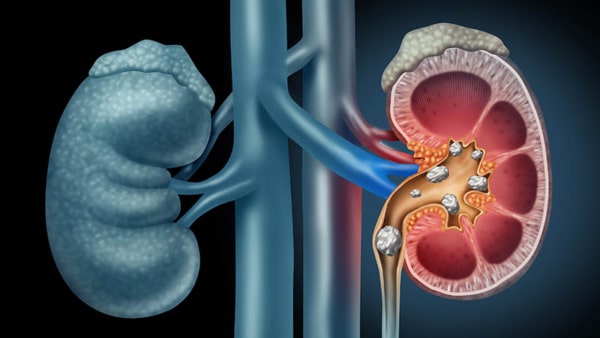It’s All Fun and Games Until Someone Gets a Kidney Stone

Summer is such a great time of year. It means family vacations, dips in the pool, and trips to the amusement parks. It’s all fun and games until someone gets a kidney stone.
Did you know that kidney stone incidents climb during the hot summer months? Let’s learn why and, more importantly, how to prevent these little kernels of pain.
Stone-Cold Facts
What is a kidney stone? A kidney stone is a hard, small formation that develops in the kidneys when urinary minerals and salts crystallize and bind together.
Kidney stones are often undetectable until they reach a specific size and move into the ureter—the tube between the kidney and the bladder. When the stone starts moving, that’s when people normally start to feel pain. The ureter is only about an eighth of an inch wide, so a tiny stone can cause severe pain. If the stone starts to block urine from passing through the ureter, it will force it back into the kidney, causing even more pain.
In general, one in 10 people will eventually experience a kidney stone.
Why Do Kidney Stones Incidents Increase During Summer
Those summertime kidney stones probably started to form months before the pool opened.
Research shows that urinary calcium is higher in winter than in summer. This is because we aren’t as active, eat more processed and salty foods, and gain weight. This leads to a buildup of waste in the body, which can increase the amount of calcium excreted in the urine. And most kidney stones—nearly 80%—are calcium-based.
Come summer, the problem compounds because of dehydration. Hot temperatures cause us to lose water through sweat, and urine becomes more concentrated when the body lacks fluids.
Prevent Summertime Stones
The easiest step to prevent kidney stones from developing is to drink lots of non-sugary fluids, which will help carry stone-contributing minerals out of the body.
We suggest drinking at least nine glasses a day for women and 13 for men. If you are sweating, increase those numbers.
Here are a few other precautionary steps:
- Cut back on the salt. Sodium increases the amount of calcium in urine. Limit processed foods, fast foods, and salty snacks.
- Reduce animal portions.Too much red meat, poultry, eggs, and seafood can raise stone-friendly uric acid levels.
- But do get some calcium.It sounds counterintuitive, but if there is too little calcium in the diet, certain acid levels will rise, and the salts from these acids (oxalates) will contribute to stone formation.
- Watch oxalates and phosphates in food.Some foods, including chocolate, beets, spinach, rhubarb, tea, and many nuts, contain high levels of oxalates. Phosphates, too, are stone culprits (think colas). Regulate these foods and pair them with water.
Kidney Stone Symptoms
The most common sign of a kidney stone is pain in the back, sides, groin, and/or testicles (for men).
The pain can be acute enough to cause nausea and vomiting, and blood may be present in the urine. Someone experiencing these symptoms should see a urologist.
The good news is that small kidney stones may pass through the body naturally within days or weeks of formation, with the help of lots of water. A doctor can provide guidance.
However, a stone must be removed if it causes complications, such as an infection or blockage. At Michigan Institute of Urology, we offer several options for stone removal.
To learn more about kidney stones, symptoms, and treatments, visit our website.

